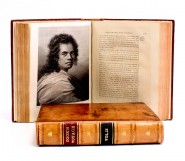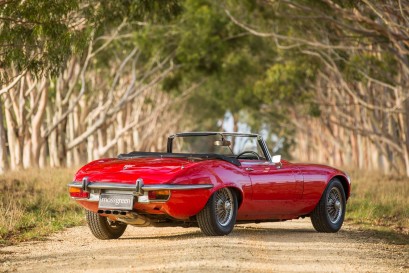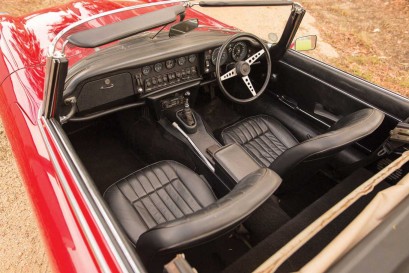Lot #37 - 1972 JAGUAR E-TYPE SERIES 3 V12 ROADSTER
-
Auction House:Mossgreen
-
Sale Name:Collectors' Cars, Motorcycles & Automobilia
-
Sale Date:19 Jun 2016 ~ 3pm
-
Lot #:37
-
Lot Description:1972 JAGUAR E-TYPE SERIES 3 V12 ROADSTER
Chassis No: 1S 1537; Engine No: 7S 8074 SB; This vehicle will be sold unregistered. -
Provenance:From the Estate of the Late John Calvert
-
Notes:The sensational Jaguar E type has forged an iconic position in automotive design since it appeared in 1961. Enzo Ferrari hailed it 'The most beautiful car ever made' (Classic Car Review 1964, article by Sean Curtis) and in 1996 the New York City Museum of Modern Art recognised the significance of the E type's design by adding a blue roadster to its permanent design collection, one of only six motor cars to receive the distinction. The E type's performance had been more than satisfactory at around 500lb (227kg) - lighter than the XK150 and with D-type experience gained by aerodynamicist Malcolm Sayer, Jaguar's racing and road car development brought forth one of the most stylish and dexterous shapes ever in original design. The lighter E type Jaguar had changed the sports car world forever. Technically, there are 3 variants of the E type; the Series 1, 2 and 3 and they were produced in 3 body styles; the roadster; the fixed-head coupe and the 2+2 fixed-head coupe. From a production view point, the Series 3 varies the most powered by a massive V12 engine dropped in from the top rather than the entire car being assembled around the twin cam straight 6 cylinder engines in the Series 1 and 2. All the production E types were made of a steel monocoque body with separate steel sub frames front and rear and the all-enclosing steel bonnet hung on the front. The gearbox and engine help brace the front sub-frame which itself supports both and also support the front wheels via torsion bar suspension. The back axle is held together by its own sub-frame fixed to the monocoque by rubber mountings allowing for 5 degrees of movement in the rear. The car that dominated sports car classes during the 1960s and remained virtually unchanged in appearance finally reached its cross road in 1969 with the Series 2 because dictatorial American modifications were having a huge impact to overall performance and the all-important top speed. Italian cars like the De Tomaso Pantera and the American V8s presented the E type a massive challenge to keep up. Emission control changes impeded performance and Jaguar realised that to compensate for the lack of horse power the Series 2 now generated they had to make a significant change to compete with their rivals. The emission regulations simply strangulated performance to a comparatively tedious 135mph and even as slow as 120 on some of the more heavily choked cars. And so it came about the V12, which had been under development for almost 10 years, was dropped in to the existing Series 2 chassis and the Series 3 was born. To accommodate the V12 engine it was decided not to use the twin overhead camshaft heads. Minimal structural changes were needed other than the front tubular framework being redesigned and strengthened; the bulkhead was enlarged and strengthened and a tie bar was applied under the motor to compensate for the extra torque; the ventilated front disks were given an air scoop to cool the rear disks-a feature of earlier racing E types. The entire floor area was lowered, power steering became standard, a smaller steering wheel and the wheel base lengthened by 9 inches. There was enough space to fit a Borg Warner automatic transmission which hence became an available option. The gearbox did not alter in the manual cars but the clutch went from 9 ? to 10 ? inches. Four Zenith constant vacuum carburettors were fitted to comply with US emission laws. The Motor's test car, a drop-head with hard-top in place, reached 146mph, albeit slower than the original E type yet it achieved 100mph in 15.4 seconds compared with 17.2 of the 4.2 coupe in a comparison test. They had to acknowledge it the quickest E type they had tested. The car had other appealing performance aspects being more flexible than the 4.2 and could almost take off from a stand-still in top gear of the clutch was manipulated accordingly. The V12 was of a refined tourer, exceedingly fast and somehow a leap in performance from its sporting siblings. The Series 3 was produced until 1974 when the US emission and safety control regulations finally strangled its very essence being speed and performance and sales suffered terminally. But, within 2 years of the end of production the Series 3 had increased in value on the second hand market with discerning buyers realising the car non-the-less represented an era of sports car never to be seen again. This Series 3 E type open two-seater is accompanied with The Jaguar Trust Heritage Certificate that states this car was manufactured as a manual, right hand drive, on 4th October, 1972 and dispatched on the 8th November, 1972, to Henlys, London. The date of import into Australia is unknown, however, the family of the Late John Calvert have confirmed his ownership of some 30 years. The car is presented in red livery with black interior trim and out of all his stable of classics was John Calvert's preferred weekend machine because of its drivability and performance. In recent years the car has been regularly serviced and maintained by the late Mr. Peter McFarlane of Geelong.
-
Estimate:A$70,000 - 90,000
-
Realised Price:
-
Category:Automobiles & Accessories
This Sale has been held and this item is no longer available. Details are provided for information purposes only.















